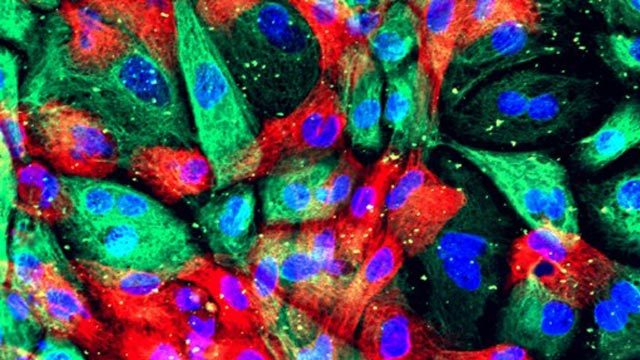Top 10 Biopharma News Stories of 2018

It has been a big year for the biopharma world. 100 years on from the 1918 global flu pandemic, it's fair to say that our understanding of viruses, diagnostics and vaccines have come a long way (read more here).
We have seen a flurry of progress in next generation cell and gene therapies, with interdisciplinary integration being a common theme among up-and-coming start-ups.
In case you missed them, here is a list of the top 10 most-read news stories we have published in 2018.
1. Hope for Glioblastoma Therapy

Image credit: University of Florida Health
University/Institute: University of Florida
Link to paper, published in: Nature Communications
In a nutshell: Hematopoietic stem cell and progenitor cells that express a certain type of receptor (C-C chemokine receptor type 2, CCR2+) play a role in overcoming brain tumor resistance to PD-1 checkpoint blockade (a type of immunotherapy).
Author insights: “Our findings are significant not only because of their implications against brain tumors but also because they may have an impact on other tumors as well. We have found that the stem cell transfer actually impacts the entire immune system, not just the tumor itself. So if we can boost a host immune system with a simple stem cell transfer, this may have huge implications across different tumor types.” -Dr. Catherine Flores, Ph.D., assistant professor in the UF College of Medicine’s Lillian S. Wells Department of Neurosurgery.
2. Aggressive Prostate and Lung Cancers Have a Common Denominator

Image credit: UCLA Health
University/Institute: University of California (Los Angeles) and Duke University
Link to paper, published in: Science
In a nutshell: A common set of defined oncogenic drivers have been identified, which reproducibly reprogram normal human prostate and lung epithelial cells to small cell prostate cancer and small lung cell cancer, respectively.
Author insights: “Our study revealed shared ‘master gene regulators’ — the key proteins that control expression of multiple genes in small cell cancer cells. Studying the network of the master gene regulators could lead to a new way of combating deadly cancers.” -Owen N. Witte.
3. Vaccination and Screening Down Under Shows Cervical Cancer the Door

Image credit: Pixabay
University/Institute: Cancer Research Division, Cancer Council NSW, Australia, University of Queensland, University of Melbourne, University of Sydney
Link to paper, published in: The Lancet
In a nutshell: Comprehensive modeling of human papillomavirus (HPV) vaccination, HPV natural history and transmission and cervical screening has led to estimates of cervical cancer incidence in Australia from 2015 to 2100. It is predicted that cervical cancer in Australia will achieve ‘rare cancer status’ by 2020, if the existing vaccination and screening protocol continues.
Author insights: “To our knowledge, this study represents the first estimation of the time to elimination of cervical cancer at a country level… Our findings imply that the elimination of cervical cancer could be on the horizon for high-income countries, such as Australia.” -study authors.
4. Fecal Microbiota Transplantation Provides Help for Cancer Patients

Credit: Jonathan Bailey, NHGRI
University/Institute: Memorial Sloan Kettering Cancer Center, University of Oxford, Boston Children’s Hospital and Harvard Medical School, Washington University in St. Louis School of Medicine, American Museum of Natural History, Weill Cornell Medical College, Rockefeller University, University of Texas MD Anderson Cancer Center.
Link to paper, published in: Science Translational Medicine
In a nutshell: Fecal microbiota transplantation (FMT) reconstituted major commensal bacterial populations in cancer patients undergoing allogeneic hematopoietic stem cell transplantation.
Author insights: “This important study suggests that clinical intervention using auto-FMT can safely reverse the disruptive effects of broad-spectrum antibiotic treatment… If validated in larger studies, this approach may prove to be a relatively simple way to quickly restore a person’s healthy microbiome following intensive antimicrobial therapy.” NIAID Director Anthony S. Fauci, M.D.
5. An Orange a Day Keeps Vision Condition Away

Image credit: Pixabay
University/Institute: The Westmead Institute
Link to paper, published in: The American Journal of Clinical Nutrition
In a nutshell: A population-based cohort study revealed evidence for an independent and protective association between dietary intake of flavonoids and the likelihood of having age-related macular degeneration.
Author insights: “Essentially we found that people who eat at least one serve of orange every day have a reduced risk of developing macular degeneration compared with people who never eat oranges… Significantly, the data did not show a relationship between other food sources protecting the eyes against the disease” -Lead Researcher and Associate Professor Bamini Gopinath.
6. Fight Influenza at the Molecular Level

Image credit: UAB
University/Institute: The University of Alabama at Birmingham
Link to paper, published in: The Journal of Biological Chemistry
In a nutshell: In a bid to improve influenza therapies against H7N9 and other influenza strains, researchers have detailed the binding site and mechanism of inhibition for two small-molecule experimental inhibitors of influenza viruses.
Author insights: "Altogether, our findings provide strong evidence for the mechanism of action of two anti-influenza compounds that target NS1, and the findings contribute significant structural insights into NS1 that we hope will promote and inform the development and optimization of influenza therapies based on A9 and A22.” -Chad Petit, Ph.D.
7. Breakthrough in Snake Evenoming

Image credit: Pixabay
University/Institute: IONTAS, Technical University of Denmark, Universidad de Costa Rica
Link to paper, published in: Nature Communications
In a nutshell: A panel of human antibodies were shown to neutralize elements of black mamba snake toxin in mice, and protect them from dendrotoxin-mediated neurotoxicity. Snakebite envenoming has recently been introduced to the World Health Organization’s list of neglected tropical diseases due to its high disease burden.
Author insights: “It is rewarding to see that classic techniques in toxinology and state-of-the-art methodologies of recombinant DNA could be successfully combined to demonstrate clear therapeutic potential. This recombinant antibody approach opens the door to the development of novel tools in the treatment of snakebites.” -Professor José María Gutiérrez, Instituto Clodomiro Picado, Universidad de Costa Rica.
8. Immunotherapy Beneficial in Some Men with Prostate Cancer

Image credit: National Institutes of Health
University/Institute: The Institute of Cancer Research, London
Unpublished. Findings were presented at the presented at the American Society of Clinical Oncology annual meeting in Chicago.
In a nutshell: A major clinical trial has become the first to show benefits of immunotherapy in prostate cancer – for some men with advanced, and otherwise untreatable, disease.
Author insights: “One of the major challenges with immunotherapy is that we don’t have many reliable tests to pick out who will benefit. This new trial has found that testing for mutations in DNA repair genes could be valuable marker of who will respond. If we can prove that in the planned new trial, it should be possible to provide some men with advanced prostate cancer with an exciting new treatment option.” -Professor Paul Workman, Chief Executive of the ICR.
9. New Way to Target the Flu Virus

Image credit: Pixabay
University/Institute: Rice University, Center for Molecular Medicine, Berlin, Baylor College of Medicine
Link to paper, published in: Proceedings of the National Academy of Sciences of the United States of America
In a nutshell: The thermodynamic importance of hemagglutinin protein HA2 refolding was quantified, using molecular dynamic simulations. A buried amino acid was implicated in destabilizing the coiled coil, a key process during viral entry of host cells. This finding is another key piece to the puzzle of finding a universal vaccine.
Author insights: "If a drug targets HA2, the domain cannot escape by making mutations because the mutations themselves would make it nonfunctional. That kind of drug could become a universal vaccine... We still have a long way to go to understand the entire protein... Here, we only studied one domain of one protein, and there are several others that are very important to its function." -Lead author Xingcheng Lin, Rice University.
10. Possible HIV-eradicating Stem Cell Transplant Factors Identified

Image credit: R. Dourmashkin, Wellcome Images, Cell Image Library
University/Institute: the IrsiCaixa AIDS Research Institute
Link to paper, published in: Annals of Internal Medicine
In a nutshell: Radical reductions in HIV-1 reservoirs have been observed following allogeneic hematopoietic stem cell transplant. This small study (n = 6) sought to identify possible mechanisms behind this observation.
Author insights: “Our goal is to elucidate the factors that help to eradicate the virus after transplant, and then mimic them with safer alternative strategies than this intervention,” concludes Javier Martínez-Picado, ICREA research professor at IrsiCaixa.
Read the full story here.
That's a wrap! What do you want to hear more about in 2019? Feel free to drop us a line in the comments below.





